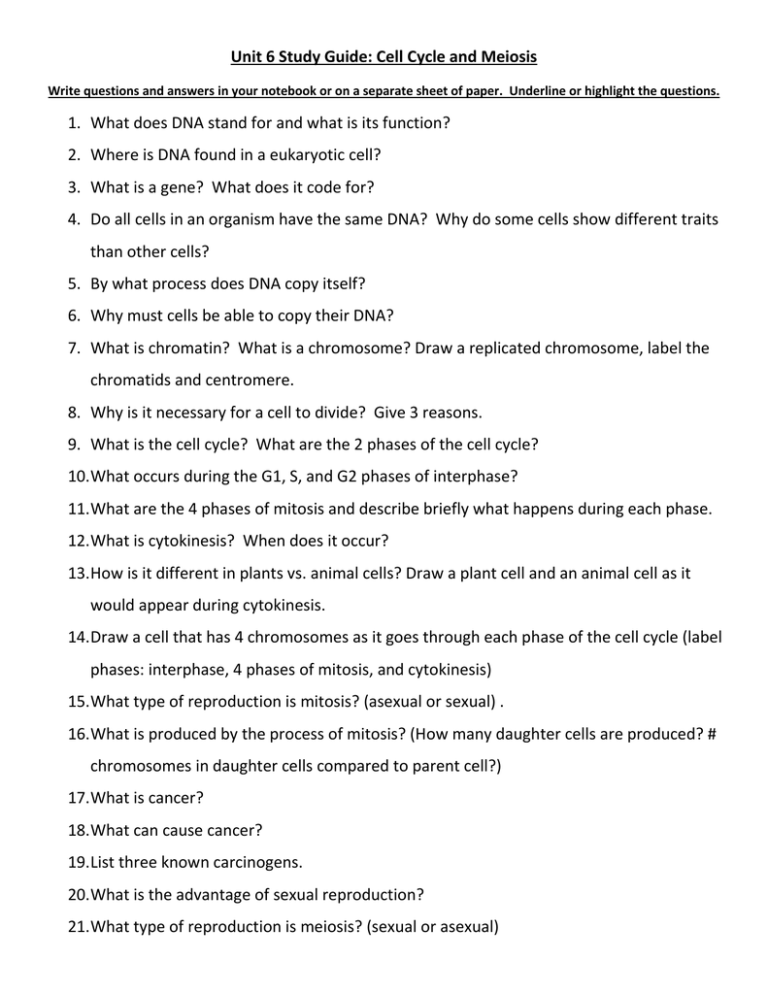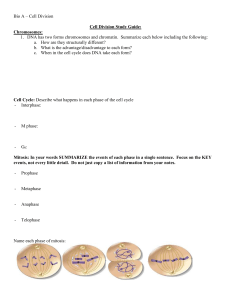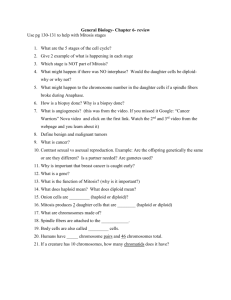Cell Cycle & Meiosis Study Guide: High School Biology
advertisement

Unit 6 Study Guide: Cell Cycle and Meiosis Write questions and answers in your notebook or on a separate sheet of paper. Underline or highlight the questions. 1. What does DNA stand for and what is its function? 2. Where is DNA found in a eukaryotic cell? 3. What is a gene? What does it code for? 4. Do all cells in an organism have the same DNA? Why do some cells show different traits than other cells? 5. By what process does DNA copy itself? 6. Why must cells be able to copy their DNA? 7. What is chromatin? What is a chromosome? Draw a replicated chromosome, label the chromatids and centromere. 8. Why is it necessary for a cell to divide? Give 3 reasons. 9. What is the cell cycle? What are the 2 phases of the cell cycle? 10.What occurs during the G1, S, and G2 phases of interphase? 11.What are the 4 phases of mitosis and describe briefly what happens during each phase. 12.What is cytokinesis? When does it occur? 13.How is it different in plants vs. animal cells? Draw a plant cell and an animal cell as it would appear during cytokinesis. 14.Draw a cell that has 4 chromosomes as it goes through each phase of the cell cycle (label phases: interphase, 4 phases of mitosis, and cytokinesis) 15.What type of reproduction is mitosis? (asexual or sexual) . 16.What is produced by the process of mitosis? (How many daughter cells are produced? # chromosomes in daughter cells compared to parent cell?) 17.What is cancer? 18.What can cause cancer? 19.List three known carcinogens. 20.What is the advantage of sexual reproduction? 21.What type of reproduction is meiosis? (sexual or asexual) 22.What is produced by the process of meiosis? (How many daughter cells are produced? # chromosomes in daughter cells compared to parent cell?) 23.What are homologous chromosomes? Are they found in diploid or haploid cells? 24.What is crossing over? When does it occur? 25.Draw the phases of Meiosis and describe what is happening in each phase. Be sure to label the phases. 26.What is a gamete? How is it produced (by what process)? Is it diploid or haploid? 27.What is a zygote? How is it produced (by what process)? Is it diploid or haploid? 28.Which process does a zygote undergo for growth? 29.What process does a cell undergo when it specializes to form different cells? 30.In terms of the parent cell’s genetic information, how does a cell compare after mitosis? After meiosis?...i.e. genetically identical or genetically different? 31.What do mitotic cell divisions and meiotic cell divisions have in common? (i.e. what has to happen in order for both processes to occur?) 32.Use the following parent cells to determine how many chromosomes would be present in a cell after mitosis and meiosis. a. Parent cell 2n = 18 chromosomes somatic cells = . gametes: . b. Parent cell 2n = 24 chromosomes somatic cells = . gametes: . c. Parent cell 2n = 46 chromosomes somatic cells = . gametes: . 33. Fill in the chart below EVENT Does DNA Replication occur? # of Divisions that occur # of Daughter Cells produced Parent cell haploid or diploid? Daughter cells haploid or diploid? MITOSIS MEIOSIS





